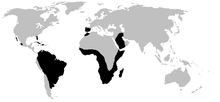Amphisbaenia
| Amphisbaenians Temporal range: Cretaceous – Recent 99–0 Ma |
|
|---|---|
 |
|
| Blanus cinereus, Spain | |
| Scientific classification | |
| Kingdom: | Animalia |
| Phylum: | Chordata |
| Class: | Reptilia |
| Order: | Squamata |
| Superfamily: | Lacertoidea |
| Clade: |
Amphisbaenia Gray, 1844 |
| Families | |
|
Amphisbaenidae |
|
 |
|
| black: range of Amphisbaenia | |
Amphisbaenidae
Bipedidae
Blanidae
Cadeidae
Rhineuridae
Trogonophidae
Amphisbaenia (called amphisbaenians or worm lizards) is a group of usually legless squamates, comprising over 180 extant species. Amphisbaenians are characterized by their long bodies, the reduction or loss of the limbs, and rudimentary eyes. As many species have a pink body and scales arranged in rings, they have a superficial resemblance to earthworms. While the genus Bipes retains forelimbs, all other genera are limbless. Although superficially similar to the snakes and Dibamidae, recent phylogenetic studies suggest that they are most closely related to the Lacertidae. Amphisbaenians are widely distributed, occurring in North America, Europe, Africa, South America, and the Caribbean. Most species are less than 6 inches (150 mm) long. Little is known of them outside of their anatomy, and even that is difficult to study due to the mechanics of dissecting such small animals.
Despite a superficial resemblance to some primitive snakes, amphisbaenians have many unique features that distinguish them from other reptiles. Internally, their right lung is reduced in size to fit their narrow bodies, whereas in snakes, it is always the left lung. Their skeletal structure and skin are also different from those of other squamates. Both genetic and recent fossil evidence indicate that amphisbaenians lost their legs independently from snakes.
The head is stout, not set off from the neck, and either rounded, sloped, or sloped with a ridge down the middle. Most of the skull is solid bone, with a distinctive single median tooth in the upper jaw. It has no outer ears, and the eyes are deeply recessed and covered with skin and scales. These rudimentary eyes have a cornea, lens, and complex ciliary body, which allows them to detect light, but they are reduced in size and do not have an anterior chamber. The body is elongated, and the tail truncates in a manner that vaguely resembles the head. Their name is derived from Amphisbaena, a mythical serpent with a head at each end. The four species of Bipes are unusual in having a pair of forelimbs, but all limbless species have some remnants of the pelvic and pectoral girdles embedded within the body musculature.
...
Wikipedia
